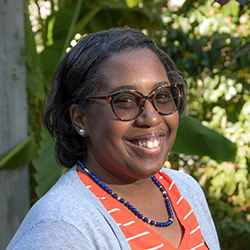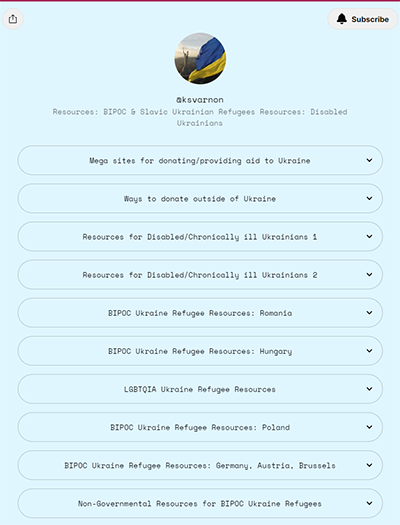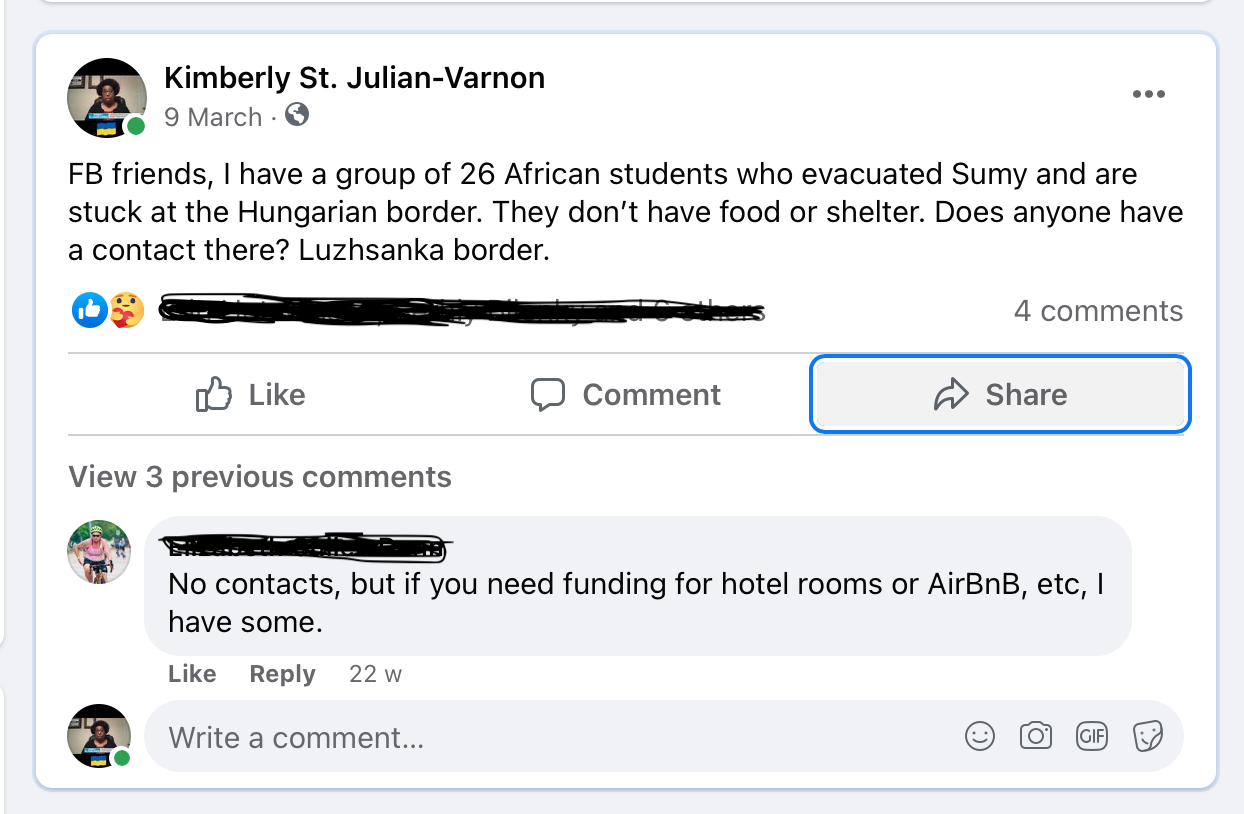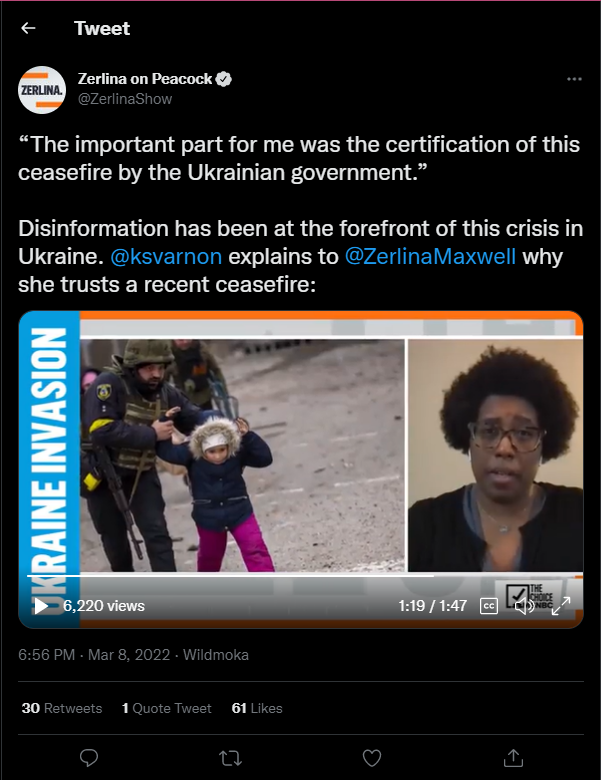by Kimberly St. Julian-Varnon

|
Kimberly St. Julian-Varnon is a doctoral student at the University of Pennsylvania and an alumna of the Harvard Ukrainian Research Institute. Her work examines how Black experience in the Soviet Union shaped Black identity, and how the presence of people of color shaped ideas and understandings of race, ethnicity, and nationality policy in the Soviet Union, East Germany, and post-Soviet space. When Russia invaded Ukraine in February 2022, Kimberly leveraged her social media presence to advocate for marginalized communities in Ukraine, counter disinformation, and share historical information about Ukraine. |
***
When the initial reports of the Russian invasion of the Donbas began to pour in, I was sitting at my desk in Texas doing my German homework. I was listening to the news, and the program was suddenly interrupted by the announcement that Russian troops had entered Ukraine. I started shrieking. I was frozen as I watched clips posted by Ukrainians on social media. I immediately had flashbacks to the spring of 2014 as I watched clips from Crimea, Luhansk, and Donetsk posted on my Ukrainian friends’ social media pages.
However, something was different this time—for Ukraine and for me. For Ukraine, the size and brutality of this invasion were of a historic magnitude. In 2014, I was a second-year master’s student in REECA at Harvard’s Davis Center, working on my thesis on the Holodomor. I watched as my professors, Serhii Plokhii and Kelly O’Neill, used their expertise to inform the public. While I did not have the expertise then, I have it now. I decided to use my voice and knowledge to fight misinformation and help the country that welcomed me in 2013 in any way that I could.
The weeks leading up to the latest invasion were fraught, and I changed the focus of my Twitter account to post threads about Ukrainian history and culture. Within a few weeks, I went from a few thousand followers to nearly 100,000. Although I was not in Ukraine, I knew how to crowdsource information on social media. Within hours of the invasion, I saw myriad posts from Ukrainians and people living and working in Ukraine looking for resources for migration to the EU or medical treatment, etc. I began to curate posts on resources and compiled them on my own.
 I created a Linktree which posted links to verified fundraising efforts and resources for the various communities within Ukraine, specifically for marginalized and special needs communities: African, Indian, and Asian refugees from Ukraine, Roma Ukrainians, LGBTQ refugees, and refugees with pressing medical needs. The Linktree now has over 40,000 views, and the tweet linking to the resources has made over 400,000 impressions. In the upcoming weeks, I hope to update it with more information as most Ukrainian refugees have moved from migration to settlement and need resources that reflect this change in their status.
I created a Linktree which posted links to verified fundraising efforts and resources for the various communities within Ukraine, specifically for marginalized and special needs communities: African, Indian, and Asian refugees from Ukraine, Roma Ukrainians, LGBTQ refugees, and refugees with pressing medical needs. The Linktree now has over 40,000 views, and the tweet linking to the resources has made over 400,000 impressions. In the upcoming weeks, I hope to update it with more information as most Ukrainian refugees have moved from migration to settlement and need resources that reflect this change in their status.
As my social media profile grew, I became a regular commentator in national media, podcasts, and radio interviews. In each, I emphasized the existential nature of this war and fought against the Russian narratives of Ukrainian Nazis and NATO puppetry. Videos of African students facing racism at the Ukraine-Poland border spread across social media in the early weeks of the war. African and Middle Eastern students were not allowed on trains going to the border and at the border they were often forced to the back of the lines processing Ukrainians leaving Ukraine and Ukrainians entering Poland and Hungary. In response, I tweeted about the history of African students in Ukraine. I explained why these students would be there. Thousands of African students studied in institutions across the Soviet Union, and this educational relationship has continued. Ukraine still offers some of the best and most affordable educational opportunities for African and Asian students seeking higher education and advanced training in medicine. A few people reached out to me looking for help for their relatives and friends who were international students in Ukraine.
Once again, I turned to social media to look for locals on the ground who could help with transportation. However, the Russian encirclement of Sumy threw me into direct contact with victims of Russian brutality. I received some messages from students stuck in their lodging in Sumy and running out of food. After verifying their identities, I asked my Twitter followers if any knew of or had any connections local to Sumy. I got fortunate. A Ukrainian woman living in Sumy answered my call. She was able to connect with the director for foreign students at Sumy State University and to get these students to the location the university was hosting and feeding international students. She continued to help me stay in touch with the students when she was also in a fraught position. I will forever be indebted to her.
 To my dismay, Russian state media started to lie about the possibility of a humanitarian corridor out of Sumy. They reported that Ukraine was not allowing civilians to leave, and this lie had life-or-death implications for the foreign students who remained in Sumy. I was in touch with a couple groups of foreign students in Sumy who were in the international student housing. By that point they were spending most of their time underground in the bomb shelters. They were cold, hungry, stressed, and afraid. Their family members and friends, who were not in Ukraine, bombarded them with false reports of humanitarian corridors. They were attempting to leave Sumy via expensive private cars that often did not make it out of the city. I spent my time tweeting verified information that there was not yet a humanitarian corridor and updating the students to keep them abreast of actual developments on the ground. One small group of students from Turkey attempted to leave Sumy at night and were shot at by Russian soldiers.
To my dismay, Russian state media started to lie about the possibility of a humanitarian corridor out of Sumy. They reported that Ukraine was not allowing civilians to leave, and this lie had life-or-death implications for the foreign students who remained in Sumy. I was in touch with a couple groups of foreign students in Sumy who were in the international student housing. By that point they were spending most of their time underground in the bomb shelters. They were cold, hungry, stressed, and afraid. Their family members and friends, who were not in Ukraine, bombarded them with false reports of humanitarian corridors. They were attempting to leave Sumy via expensive private cars that often did not make it out of the city. I spent my time tweeting verified information that there was not yet a humanitarian corridor and updating the students to keep them abreast of actual developments on the ground. One small group of students from Turkey attempted to leave Sumy at night and were shot at by Russian soldiers.
Adding insult to injury, the Russian Foreign Ministry (RFM)’s social media accounts reposted videos made by African students. These students, who were clearly in distress, alleged that they were being kept in Sumy as human shields by Ukrainians who would not allow them to leave the city. These students were unknowingly repeating Russian state talking points about the siege of Sumy. The RFM dared to claim that Ukraine was mistreating the African students, even though it was the Russian soldiers who had made Sumy unsafe. Thousands of people retweeted and shared that tweet, and I was both livid and deflated. It seemed impossible to overcome the daily onslaught of disinformation and willful ignorance flooding social media. Despite these harrowing days, eventually a humanitarian corridor did open. All the students I was in contact with were able to get out of Ukraine, and most of them returned to their home countries.
 In the past few months, I have focused on using my writing and my voice to continue to fight Russian disinformation online and in public forums. This is where I feel I can be the most helpful and have the most impact on behalf of the Ukrainian war effort. If anyone takes a lesson from my experience, I hope they learn that we can all do something. I cannot go to Ukraine and fight against Russia. I cannot go to Poland and help process refugees. However, I can use the tools I have at my disposal to keep the West's public eye on Ukraine and highlight the deeply disturbing repetition of Russian falsehoods in public discourse. Western silence and forgetfulness are the tools Russia depends on, and I will do what I can to ensure those two things do not happen.
In the past few months, I have focused on using my writing and my voice to continue to fight Russian disinformation online and in public forums. This is where I feel I can be the most helpful and have the most impact on behalf of the Ukrainian war effort. If anyone takes a lesson from my experience, I hope they learn that we can all do something. I cannot go to Ukraine and fight against Russia. I cannot go to Poland and help process refugees. However, I can use the tools I have at my disposal to keep the West's public eye on Ukraine and highlight the deeply disturbing repetition of Russian falsehoods in public discourse. Western silence and forgetfulness are the tools Russia depends on, and I will do what I can to ensure those two things do not happen.
I have worked with these organizations to raise awareness about the war and for donations: Razom for Ukraine, Ukrainian Catholic University, and the Kyiv School of Economics.